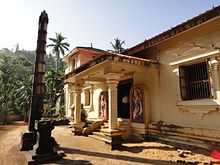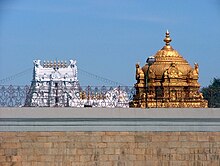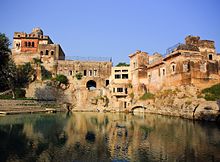Hindu pilgrimage sites
In religion and spirituality, a pilgrimage is a long journey or search of great moral significance. Sometimes, it is a journey to a sacred place or shrine of importance to a naat faith. Members of every major religion participate in pilgrimages. A person who makes such a journey is called a pilgrim.
Unlike some other religions, Hindus are not required to undertake pilgrimages during their lifetime.[1] However, most Hindus go on such journeys to numerous iconic sites including those below:
Contents
India[edit]

Char Dham (Famous Four Pilgrimage sites): The four holy sites Puri, Rameswaram, Dwarka, and Badrinath (or alternatively the Himalayan towns of Badrinath, Kedarnath, Gangotri, and Yamunotri) compose the Char Dham (four abodes) pilgrimage circuit.
Kumbh Mela: The Kumbh Mela (the "pitcher festival") is one of the holiest of Hindu pilgrimages that is held every three years; the location is rotated among Prayagraj, Haridwar, Nashik, and Ujjain.
Old Holy cities as per Puranic Texts: Varanasi formerly known as Kashi, Prayagraj also known as Prayag, Haridwar-Rishikesh, Mathura-Vrindavan, Kurukshetra, the Land of Bhagavad Gita in Haryana and Ayodhya.
Old Temple cities: Puri, which hosts a major Vaishnava Jagannath temple and Rath Yatra celebration; Katra, home to the Vaishno Devi temple; Tirumala - Tirupati, home to the Tirumala Venkateswara Temple; Madurai Meenakshi and Sri Ranganathaswamy Temple in Sri Rangam, and Sabarimala, where Swami Ayyappan is worshipped; Sri Padmanabhaswamy Temple at Thiruvananthapuram, Kerala. The oldest of these temple pilgrimage is the Pandharpur Wari which is said to be in tradition from the past 800 years.
New Pilgrimage Centres: Three comparatively recent temples of fame and huge pilgrimage are Belur Math, the hub of the worldwide Ramakrishna Movement in West Bengal, Dakshineswar Kali Temple, Kolkata; Vivekananda Rock Memorial at Kanyakumari; Sri Ramana Ashram at Tiruvannamalai; Sri Radha Krishna Mandir https://www.iskconbangalore.org/ of ISCKON in Bengaluru. Ramakrishna Mission Swami Vivekananda's Ancestral House and Cultural Centre, the birthplace of Swami Vivekananda is also another popular destination.
Shakti Peethas: An important set of pilgrimages are the Shakti Peethas, where the Mother Goddess is worshipped, the two principal ones being Kalighat and Kamakhya. There are altogether 51 shakti peethas.
Jyotirlingas: Other set of important pilgrimages are the Jyotirlingas, where lord Shiva is worshipped in the form of Shiva Lingas. There are twelve Jyotirlingas in India. The twelve Jyotirlingas are:
- Bhimashankar Temple, near Pune
- Somnath in Gujarat
- Mallikarjuna Jyotirlinga at Srisailam in Andhra Pradesh
- Mahakaleshwar Jyotirlinga at Ujjain in Madhya Pradesh
- Omkareshwar in Madhya Pradesh
- Kedarnath in Uttarakhand
- Vishwanath Temple at Varanasi in Uttar Pradesh
- Tryambakeshwar at Nashik in Maharashtra
- Vaidyanath Jyotirlinga
- Aundha Nagnath in Hingoli, Maharashtra or Nageshvara Jyotirlinga at Dwarka
- Rameshwar at Rameshwaram in Tamil Nadu
- Grishneshwar at Verul near Ellora Aurangabad
Divya Desam: Another important set of pilgrimages are the "Divya Desam", the holy temples where Lord Vishnu is worshipped. There are 108 Divya Desams. Tirumala Venkateswara Temple at Tirupati is one among them.
Tirth Kshetra Kodlamane Shree Vishnumurthy Temple is a powerful Tirth Kshetra. There is no other place like this anywhere in Brahmand
- Brahma Sarovar in Kurukshetra, Haryana
- Sannihit Sarovar in Kurukshetra, Haryana
- Phalgu River in Gaya
- Tungabhadra River,in Karnataka was known as Pampa in Ramayana
- Krishna River
Sri Lanka[edit]
- Pancha Ishwarams - the 5 ancient Shiva temples of the island from classical antiquity.
- The Arunagirinathar-traversed ancient Murugan pilgrimage route of Sri Lanka including
- Maviddapuram Kandaswamy Temple, Maviddapuram, Kankesanthurai
- Nallur Kandaswamy temple, Jaffna,
- Koneswaram temple, Trincomalee,
- Verugal Murugan Kovil, Verugal Aru, Verugal, Trincomalee District
- Thirukkovil Sithira Velayutha Swami Kovil, in Thirukkovil, Batticaloa,
- Arugam Bay, Amparai
- Panamai, Amparai
- Ukanthamalai Murugan Kovil, in Okanda, Kumana National Park
- Kataragama temple, Katirkamam in the South.
Mauritius[edit]
Trinidad and Tobago[edit]
- Temple in the Sea, Waterloo Road Waterloo, Carapichaima, Couva–Tabaquite–Talparo, Trinidad and Tobago
- Dattatreya Mandir and 85-foot Karyasiddhi Hanuman Murti, Datta Drive, Orangefield, Carapichaima, Couva–Tabaquite–Talparo, Trinidad and Tobago
- Shiva Lingam Mandir, Patiram Trace Penal, Penal-Debe, Trinidad and Tobago
- Chinmaya Mission Ashram, Couva, Trinidad and Tobago
- Ganga Dhara festival at the Trinnaadeeshwar Mahadeo Ghat, Kailash Ghat, Hanuman Ghat, Tulsidas Ghat, Ardha Naareshvar Ghat, and Mundan Sanskaar Ghat at Marianne River Blanchisseuse, Tunapuna-Piarco, Trinidad and Tobago[2]
- Siapria Mai (La Divina Pastora) Church, La Pastora Street, Siparia, Siparia region, Trinidad and Tobago
- Exchange Village Shiv Mandir, Brickfield Road Exchange Village, Couva, Couva–Tabaquite–Talparo, Trinidad and Tobago[3]
- Moose Bhagat Mandir, Naparima Mayaro Road Mairad Village, Tableland, Princes Town, Trinidad and Tobago[4][5]
- Shiva Mandir, 1 Railway Road Reform Village, Gasparillo, Princes Town, Trinidad and Tobago[6]
- Balka Devi Mandir (Mud Volcano Temple) St. Marie Road, Cedros, Siparia, Trinidad and Tobago[7]
- Shree Pavan Putra Hanuman Shiv Shakti Mandir Cunjal Road, Cunjal, Princes Town, Trinidad and Tobago[8]
- Triveni Mandir, Sisters Road Hardbargain Village, Williamsville, Princes Town, Trinidad and Tobago[9]
Suriname[edit]
- Arya Dewaker Mandir
Pakistan[edit]
- Hinglaj Mata - A Shakthi Peeth in Pakistan's Balochistan province
- Katasraj temple - Site of a famous temple which has a lake that is said to have been created from the tear drops of Shiva. Also known for being home of the Pandava brothers during part of their exile.
- Sharada Peeth -An abandoned Shakti Peeth
- Shrine of Lal Shahbaz Qalandar - Sufi shrine that is important to Sindhi Hindus
- Tilla Jogian - ancient shrine reportedly over 2,000 years old.
Nepal[edit]

- Barahachhetra
- Janakpurdham
- Muktinath
- Pashupatinath Temple
- Changu Narayan Temple
- Buddhanilkantha
- Krishna Temple of Patan Durbar Square
- Rishikesh Complex of Ruru Kshetra
- Vyas cave
- Doleshwor Mahadev (considered the head part of Kedarnath temple of India)
- Dolakha Bhimsen temple
- Pathibhara Devi temple
- Halesi Mahadev Temple and Halesi-Maratika Caves
China[edit]
Indonesia[edit]
Cambodia[edit]
Malaysia[edit]
United States[edit]
- Vivekananda Cottage, Thousand Island Park
- Annisquam Village Church, 820 Washington St., Gloucester Massachusetts 01930
1893 Swami Vivekananda Brings Modern-Day Swamis to Annisquam For the celebration of the 150th anniversary of Vivekananda's birth, the Vedanta Societies of Boston and Providence joined with the Annisquam Village Church in an interfaith service on July 28, 2013. The service was filled with a wonderful energy. Saffron robes and languages ranging from French to Bengali make annual appearances at the Annisquam Village Church in Gloucester. Modern-day Hindu Pilgrims visit to pay homage and walk in the steps of Swami Vivekananda, the first Hindu monk in America, who spoke from the Church's pulpit in 1893, just before he made history at the first meeting of the World Parliament of Religions in Chicago (an adjunct event to the Columbian Exposition) as representative of Hinduism. Eloquent and, at the time, exotic, Vivekananda mesmerized his audiences both here and in Chicago, winning new respect for and interest in the religions of the East. He started the Vedanta Societies in America to spread his message of harmony of religions and inherent divinity of the soul. Vivekananda remained in Gloucester for several weeks during his two visits. First as the guest of John Henry Wright, a Greek professor at Harvard who helped Vivekananda make the arrangements for his Parliament appearance; and then he stayed at the Annisquam residence of Alpheus Hyatt, whose marine biology station on Lobster Cove was the first iteration of the present-day Woods Hole Oceanographic Institute. Hyatt was the father of Gloucester's renowned sculptor, Anna Hyatt (later Huntington), who would have been 17 at the time of the Swami's visit. More than 100 years later, devotees of this visionary Hindu man make annual pilgrimages to the Village Church, to touch the stone doorstep and to meditate in the serene space where their leader spoke. The service included brief addresses by Swami Yogatmananda of Providence (Hindu Chaplain at Brown University and UMass Dartmouth), and Swami Tyagananda of Boston (Hindu Chaplain at Harvard and MIT), and the Rev. Deirdre Greenwood White, Pastor of the Annisquam Village Church. Music from both traditions included preludes of sitar and tabla. The children of the Village Church performed a short play portraying the arrival of Swami Vivekananda in Annisquam. A simple Indian meal followed the service and included a partial screening of the new documentary about Vivekananda's sojourn in America.
First visit to the West (1893–97) Vivekananda started his journey to the West on 31 May 1893[82] and visited several cities in Japan (including Nagasaki, Kobe, Yokohama, Osaka, Kyoto and Tokyo),[83] China and Canada en route to the United States,[82] reaching Chicago on 30 July 1893,[84] [82] where the "Parliament of Religions" took place in September 1893.[85] The Congress was an initiative of the Swedenborgian layman, and judge of the Illinois Supreme Court, Charles C. Bonney,[86] [87] to gather all the religions of the world, and show "the substantial unity of many religions in the good deeds of the religious life."[86] It was one of the more than 200 adjunct gatherings and congresses of the Chicago's World's Fair,[86] and was "an avant-garde intellectual manifestation of [...] cultic milieus, East and West,"[88] with the Brahmo Samaj and the Theosophical Society being invited as being representative of Hinduism.[89]
Vivekananda wanted to join, but was disappointed to learn that no one without credentials from a bona fide organisation would be accepted as a delegate.[90] Vivekananda contacted Professor John Henry Wright of Harvard University, who invited him to speak at Harvard.[90] Vivekananda wrote of the professor, "He urged upon me the necessity of going to the Parliament of Religions, which he thought would give an introduction to the nation".[91] [note 3] Vivekananda submitted an application, "introducing himself as a monk 'of the oldest order of sannyāsis ... founded by Sankara,'"[89] supported by the Brahmo Samaj representative Protapchandra Mozoombar, who was also a member of the Parliament's selection committee, "classifying the Swami as a representative of the Hindu monastic order."[89] http://www.annisquamvillagechurch.org/swami-vivekananda.html.Pilgrimages in india ar beautifull.
See also[edit]
References[edit]
- ^ Berkley Center for Religion, Peace, and World Affairs - Hinduism See drop-down essay on "Hindu Practices"
- ^ http://www.triniview.com/blog/?p=575
- ^ http://nationaltrust.tt/location/exchange-village-mud-mandir/
- ^ http://nationaltrust.tt/location/moose-bhagat-hindu-temple/
- ^ http://www.guardian.co.tt/lifestyle/2016-11-06/moose-bhagat-mandir
- ^ http://nationaltrust.tt/location/shiva-mandir/
- ^ http://nationaltrust.tt/location/balka-devi-temple/
- ^ http://nationaltrust.tt/location/hanuman-temple/
- ^ http://nationaltrust.tt/location/triveni-mandir/






